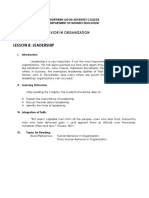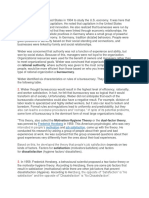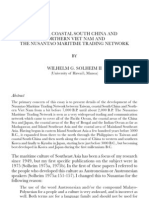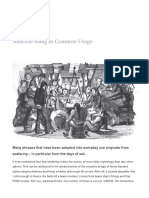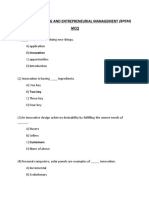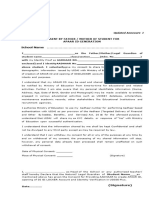0 ratings0% found this document useful (0 votes)
54 viewsA. Defining Charismatic Leadership
A. Defining Charismatic Leadership
Uploaded by
Jose Lester Correa DuriaThis document discusses transformational leadership and the charismatic trait. It defines charismatic leadership, provides examples of charismatic leaders like Martin Luther King Jr. and Mother Theresa, and explores the requirements and advantages/disadvantages of charismatic leadership. Specifically, it notes that charismatic leaders are skilled communicators who inspire people through a shared vision but may also develop arrogance or tunnel vision.
Copyright:
© All Rights Reserved
Available Formats
Download as DOCX, PDF, TXT or read online from Scribd
A. Defining Charismatic Leadership
A. Defining Charismatic Leadership
Uploaded by
Jose Lester Correa Duria0 ratings0% found this document useful (0 votes)
54 views2 pagesThis document discusses transformational leadership and the charismatic trait. It defines charismatic leadership, provides examples of charismatic leaders like Martin Luther King Jr. and Mother Theresa, and explores the requirements and advantages/disadvantages of charismatic leadership. Specifically, it notes that charismatic leaders are skilled communicators who inspire people through a shared vision but may also develop arrogance or tunnel vision.
Original Title
Charismatic Trait.docx
Copyright
© © All Rights Reserved
Available Formats
DOCX, PDF, TXT or read online from Scribd
Share this document
Did you find this document useful?
Is this content inappropriate?
This document discusses transformational leadership and the charismatic trait. It defines charismatic leadership, provides examples of charismatic leaders like Martin Luther King Jr. and Mother Theresa, and explores the requirements and advantages/disadvantages of charismatic leadership. Specifically, it notes that charismatic leaders are skilled communicators who inspire people through a shared vision but may also develop arrogance or tunnel vision.
Copyright:
© All Rights Reserved
Available Formats
Download as DOCX, PDF, TXT or read online from Scribd
Download as docx, pdf, or txt
0 ratings0% found this document useful (0 votes)
54 views2 pagesA. Defining Charismatic Leadership
A. Defining Charismatic Leadership
Uploaded by
Jose Lester Correa DuriaThis document discusses transformational leadership and the charismatic trait. It defines charismatic leadership, provides examples of charismatic leaders like Martin Luther King Jr. and Mother Theresa, and explores the requirements and advantages/disadvantages of charismatic leadership. Specifically, it notes that charismatic leaders are skilled communicators who inspire people through a shared vision but may also develop arrogance or tunnel vision.
Copyright:
© All Rights Reserved
Available Formats
Download as DOCX, PDF, TXT or read online from Scribd
Download as docx, pdf, or txt
You are on page 1of 2
DURIA, JOSE LESTER C.
TRANSFORMATIONAL LEADERSHIP
DPE
I. The Charisma Trait
A. Defining charismatic leadership
1. Skilled communicators
2. Often identified in times of crisis
3. Exhibit exceptional devotion to and expertise in their fields
4. Charismatic leadership depends on the personality and actions of the leader
B. Examples of Charismatic Leadership
1. Martin Luther King Jr. –he ignited smaller movements for equal rights through the American South and beyond.
2. Mother Theresa -her inspiring, devout persona and devotion to a singular idea make her a good example of a
charismatic leader.
3. Pope John Paul II -was instrumental in examining the Roman Catholic Church’s role in the modern world. He
traveled to more than 100 countries and was a vocal advocate for human rights.
4. Winston Churchill -was a powerful orator who used radio speeches to buoy the British people’s resilience
during Germany’s World War II bombing of England.
5. Ronald Reagan -was able to articulate his political vision in ways that appealed to his followers. He is
recognized as one of the most charismatic American presidents of the 20th century.
C. Charismatic leadership style requirement
1. Sensitivity to their environment and the needs of their employees or followers
2. Articulate and visionary
3. Inclined toward personal risk taking
4. Adept at using unconventional behavior
D. Advantages and disadvantages of charismatic leadership
1. Charismatic leadership pros:
-Charismatic leaders inspire people to work together for a common cause
-Organizations are committed to a central mission
-Management prioritizes learning from mistakes in an effort to succeed in their mission
-Charismatic-led companies tend to be cohesive because their workers have a clear purpose
2. Charismatic leadership cons:
-Leaders may develop tunnel vision or arrogance, undoing their previous good deeds
-Organizations can become dependent on charismatic leaders and may suffer if he or she retires,
leaves the company, or dies suddenly
-Charismatic leaders sometimes become unresponsive to their subordinates or constituents
-These leaders may not learn from their mistakes, compounding them
-Charismatic leaders may believe they are above the law, committing financial or ethical violations
E. Benefits of charismatic leadership
-They fight for quality of life and a better world
-They have the courage of their convictions.
-They are willing to stand up to people who have a differing view of society or the organization
-They tend to be able to see the gaps between what an organization delivers to its workers and what the
workers need from the organization.
-They create visions that their supporters can readily see, and in return the supporters are motivated to
contribute to a common goal.
II. Inspirational Motivation
-The Inspirational Motivation dimension is produced through behaviors that facilitate a feeling of
optimism and a commitment to organizational goals and vision.
You might also like
- Summary of The 21 Irrefutable Laws of Leadership: by John C. Maxwell | Includes AnalysisFrom EverandSummary of The 21 Irrefutable Laws of Leadership: by John C. Maxwell | Includes AnalysisRating: 5 out of 5 stars5/5 (1)
- Midterm FinalDocument84 pagesMidterm FinalSgt100% (1)
- The Great Man Theory-1Document6 pagesThe Great Man Theory-1Sidra Afzal100% (1)
- Chapter 8 LeadershipDocument28 pagesChapter 8 LeadershipEloisa Karen MonatoNo ratings yet
- To What Extent Is Leadership Culturally ContingentDocument4 pagesTo What Extent Is Leadership Culturally Contingentimran27pk50% (2)
- Concept 1 - Leadership & Management in NursingDocument652 pagesConcept 1 - Leadership & Management in Nursingezenz0205100% (4)
- Chapter 2 - Leadership EquationDocument4 pagesChapter 2 - Leadership EquationFrancisNo ratings yet
- Leadership 2017Document9 pagesLeadership 2017Joeriel JimenezNo ratings yet
- Finals UtsDocument2 pagesFinals UtsFaith Hannah OroNo ratings yet
- MTP 4Document36 pagesMTP 4Chum Desalegn KanbiroNo ratings yet
- Soft SkillsDocument3 pagesSoft SkillsTeja ChodeNo ratings yet
- Charismatic and Transformational LeadersDocument7 pagesCharismatic and Transformational LeaderskrirughaniNo ratings yet
- Module 3 Leadership 2Document17 pagesModule 3 Leadership 2Plum BoiiNo ratings yet
- Leadership ModuleDocument4 pagesLeadership ModuleAnderson OrtegaNo ratings yet
- Management Leadership NewDocument47 pagesManagement Leadership NewDarshana LondheNo ratings yet
- Chapter 3 NSTPDocument15 pagesChapter 3 NSTPAlthea Faye Rabanal100% (2)
- Module 1Document11 pagesModule 1thejasvisurya58No ratings yet
- Bad LeadershipDocument13 pagesBad LeadershipKirimi Barine0% (1)
- Bbsb4103 Slides Chapter 7Document22 pagesBbsb4103 Slides Chapter 7Azizi JaisNo ratings yet
- Leadership: Click To Edit Master Title StyleDocument35 pagesLeadership: Click To Edit Master Title StyleMark Jasön PinedaNo ratings yet
- DR AMN (OB) B2G1Document16 pagesDR AMN (OB) B2G1aungmin nyoNo ratings yet
- Finals importantsDocument12 pagesFinals importantsSyedzulfiqar Hadi72No ratings yet
- Chapter 5.leadershipDocument8 pagesChapter 5.leadershipGiana CalloNo ratings yet
- Theories of Leadership: Session-2Document33 pagesTheories of Leadership: Session-2amol_more37No ratings yet
- NSTP - 1 Chapter 4Document49 pagesNSTP - 1 Chapter 4amyrfabiaNo ratings yet
- Week 7Document50 pagesWeek 7MOHAMMAD AMIN BIN ROSDINo ratings yet
- Leadership & Governance (Document24 pagesLeadership & Governance (oforijulius77No ratings yet
- Character FormationDocument43 pagesCharacter FormationAnnafe MedenillaNo ratings yet
- Handouts in LeadershipDocument22 pagesHandouts in LeadershipMa Carmel Jaque100% (2)
- School LeadershipDocument3 pagesSchool Leadershipsaira tariqNo ratings yet
- Transformational LeadershipDocument11 pagesTransformational LeadershipHami YaraNo ratings yet
- Here's A SimpliDocument21 pagesHere's A SimpliIqra SaeedNo ratings yet
- Chapter 4Document8 pagesChapter 4Nguyễn Minh AnhNo ratings yet
- Charismatic LeadershipDocument12 pagesCharismatic LeadershipAzra IshratNo ratings yet
- Social LeadershipDocument11 pagesSocial LeadershipHedayatullah PashteenNo ratings yet
- Social Influences Leadership and FellowershipDocument5 pagesSocial Influences Leadership and FellowershipQueenieCatubagDomingoNo ratings yet
- Leadership Theories HandoutDocument12 pagesLeadership Theories HandoutAnthony RiggsNo ratings yet
- Module VDocument17 pagesModule VashithaprNo ratings yet
- CLFM2 1Document30 pagesCLFM2 1Mark james OngandoNo ratings yet
- Leadership: Xhosa International IncDocument6 pagesLeadership: Xhosa International IncWinston JosephNo ratings yet
- Public Ad-8Document18 pagesPublic Ad-8KhansaNo ratings yet
- Chapter-3 Charismatic and Transformational LeadershipDocument21 pagesChapter-3 Charismatic and Transformational LeadershipSyed MotashamNo ratings yet
- 1.1 Leadership and Leadership TheoriesDocument11 pages1.1 Leadership and Leadership TheoriesGANELA REGILYN B.No ratings yet
- Charismatic LeadershipDocument3 pagesCharismatic LeadershipAdnan Al ShahidNo ratings yet
- Q6-OB AnsDocument2 pagesQ6-OB AnsMUHAMMAD HAMZANo ratings yet
- 144 LeadershipDocument143 pages144 LeadershipAndualem hailieNo ratings yet
- Charismatic LeadershipDocument3 pagesCharismatic LeadershipNa Omar FarukNo ratings yet
- Types of Leadership Styles: "The Best Way To Have A Good Idea, Is To Have A Lot of Ideas."Document9 pagesTypes of Leadership Styles: "The Best Way To Have A Good Idea, Is To Have A Lot of Ideas."Rahulanandsharma100% (1)
- NCM 119 Module (1) - 1Document134 pagesNCM 119 Module (1) - 1yuuki konnoNo ratings yet
- Charismatic LeadershipDocument6 pagesCharismatic LeadershipSyed ParasNo ratings yet
- Guide to John C. Maxwell’s The 21 Irrefutable Laws of LeadershipFrom EverandGuide to John C. Maxwell’s The 21 Irrefutable Laws of LeadershipNo ratings yet
- CFLM PART 2Document23 pagesCFLM PART 2zaneazekielNo ratings yet
- The History of Leadership Studies and Evolution of Leadership TheoriesDocument5 pagesThe History of Leadership Studies and Evolution of Leadership Theorieshuzaifasalman101No ratings yet
- LTM PPT CompleteDocument130 pagesLTM PPT Completeajayrocky167No ratings yet
- NSTP 2 Lesson 3-Leadership and TrainingDocument34 pagesNSTP 2 Lesson 3-Leadership and TrainingChristopher Toff Layupan100% (1)
- HBO Chapter 8 - LeadershipDocument14 pagesHBO Chapter 8 - LeadershipSussie Gani100% (1)
- GOODDocument23 pagesGOODLeanna JalbuenaNo ratings yet
- Semi UtsDocument2 pagesSemi UtsTrisha ApalisNo ratings yet
- Chapter 7 LeadershipDocument28 pagesChapter 7 LeadershipLYRRAHNo ratings yet
- AMethodof Phenomenological InterviewingDocument10 pagesAMethodof Phenomenological InterviewingJose Lester Correa DuriaNo ratings yet
- Corporate Social ResponsibilityDocument24 pagesCorporate Social ResponsibilityJose Lester Correa DuriaNo ratings yet
- Rational Authority Bureaucracy: Frederick Herzberg Motivation Job SatisfactionDocument3 pagesRational Authority Bureaucracy: Frederick Herzberg Motivation Job SatisfactionJose Lester Correa DuriaNo ratings yet
- SakdalismDocument16 pagesSakdalismJose Lester Correa Duria100% (1)
- UBD Lesson PlanDocument14 pagesUBD Lesson PlanJose Lester Correa DuriaNo ratings yet
- Historiography in The PhilippinesDocument26 pagesHistoriography in The PhilippinesJose Lester Correa Duria100% (1)
- Solheim On NusantaoDocument12 pagesSolheim On NusantaoJose Lester Correa DuriaNo ratings yet
- Millat TractorsDocument16 pagesMillat TractorsNoman AmjadNo ratings yet
- Yogini Mataji 5Document12 pagesYogini Mataji 5sudiman_liu100% (1)
- Nautical Slang in Common UsageDocument9 pagesNautical Slang in Common UsageJacketNo ratings yet
- Transactional Theory: Name: Wardinah Syafinah Binti Taib Khan MATRIC NUMBER: 262820Document11 pagesTransactional Theory: Name: Wardinah Syafinah Binti Taib Khan MATRIC NUMBER: 262820Wardinah SyafinahNo ratings yet
- SWOT ANALYSIS-WPS OfficeDocument4 pagesSWOT ANALYSIS-WPS OfficeAbiñon Clark Kevin T.No ratings yet
- The Forgotten Genocide Eastern Christians, The Last Arameans (Sébastien de Courtois)Document402 pagesThe Forgotten Genocide Eastern Christians, The Last Arameans (Sébastien de Courtois)hunter ZNo ratings yet
- PG MQ Mopup Allotments List College Wise Iccc IndiaDocument24 pagesPG MQ Mopup Allotments List College Wise Iccc Indiadivyajadam12No ratings yet
- Week2 NPTELDocument2 pagesWeek2 NPTELPriya SundarNo ratings yet
- Product Lifecycle Management Introductory GuideDocument52 pagesProduct Lifecycle Management Introductory GuideAditya Soumava75% (4)
- Jawaharlal Nehru National Solar MissionDocument55 pagesJawaharlal Nehru National Solar MissionIshan TiwariNo ratings yet
- Islam Ic Studies Mcqs in English For BdsDocument9 pagesIslam Ic Studies Mcqs in English For Bdsfatimaiqbal.12aNo ratings yet
- Business Planning Entrepreneurial Management FinalDocument40 pagesBusiness Planning Entrepreneurial Management Finalkomal mansukhani100% (1)
- GlobalizationDocument9 pagesGlobalizationEstella ManeaNo ratings yet
- Nimrod - A Mighty Hunter in Opposition To JehovahDocument9 pagesNimrod - A Mighty Hunter in Opposition To JehovahDMTitus100% (1)
- APAAR ID (Consent Form) UdiseDocument1 pageAPAAR ID (Consent Form) UdiseSchool Foodie0% (1)
- 380Ai2TS - 1 Marks of Class 9Document2 pages380Ai2TS - 1 Marks of Class 9ahana2024poddarNo ratings yet
- Mediation of India PakistanDocument31 pagesMediation of India PakistanVineetha KanchumarthiNo ratings yet
- Stat Report Andhra Pradesh2014Document492 pagesStat Report Andhra Pradesh2014kdineshcNo ratings yet
- TOK - IA Prompts - Ahmad AzlanDocument2 pagesTOK - IA Prompts - Ahmad AzlanAdlinNo ratings yet
- Learning Task No. 1.2Document3 pagesLearning Task No. 1.2Carl Oliver LacanlaleNo ratings yet
- Free General Medical Camp Report General - 2022Document44 pagesFree General Medical Camp Report General - 2022amar vyasNo ratings yet
- Government Assistance-No Specific Relation To Operating ActivitiesDocument4 pagesGovernment Assistance-No Specific Relation To Operating ActivitiesEvelina Del RosarioNo ratings yet
- KHPT Application Form FinalDocument4 pagesKHPT Application Form FinalSahana NaikNo ratings yet
- Violations of The Corporation CodeDocument4 pagesViolations of The Corporation CodeWarren Junior M. GloryNo ratings yet
- 10-03-2016 ECF 736 USA V RYAN PAYNE - MOTION Re Appointment of Special MasterDocument7 pages10-03-2016 ECF 736 USA V RYAN PAYNE - MOTION Re Appointment of Special MasterJack RyanNo ratings yet
- Piggery Farming in Tripura An OverviewDocument10 pagesPiggery Farming in Tripura An OverviewAbdur Rahman Choudhury100% (1)
- EMPTECH 3rd Quarterly ExamDocument2 pagesEMPTECH 3rd Quarterly ExamyhanatimpugNo ratings yet
- BCOC-133: Bachelor in Commerce (B. Com.) Term-End Examination June, 2022Document7 pagesBCOC-133: Bachelor in Commerce (B. Com.) Term-End Examination June, 2022LavanyaNo ratings yet
- Conflict Between Ambani BrothersDocument11 pagesConflict Between Ambani Brothersarpita nayakNo ratings yet
- Pre-Trial SPA W/ AcknowledgementDocument2 pagesPre-Trial SPA W/ AcknowledgementN.A. BrualNo ratings yet























































